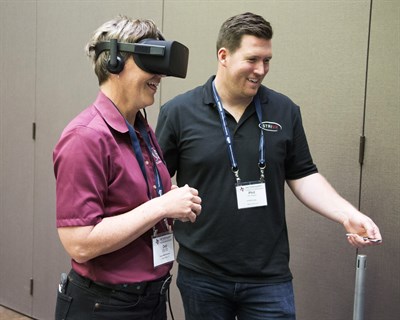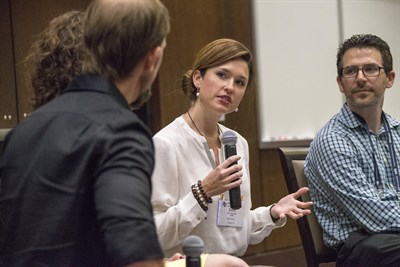Innovation Summit: A Game Changer
The Texas A&M College of Veterinary Medicine & Biomedical Sciences (CVM) and the North American Veterinary Community (NAVC) welcomed game-changers, innovators, entrepreneurs, and visionaries to the Veterinary Innovation Summit (VIS) in late spring 2017. At the event, veterinary and non-veterinary entrepreneurs and health professionals shared fresh perspectives on the latest technologies, debated controversial issues, fostered new ideas, and catapulted the profession into the future with fearlessness and innovation.
It is clear that the world is changing, not just at a linear rate, but exponentially, and these changes are having a profound effect on veterinary medicine. At the Texas A&M University College of Veterinary Medicine & Biomedical Sciences (CVM), we are dedicated to sparking and fostering ingenuity. The inaugural Veterinary Innovation Summit (VIS) on April 28–30, 2017, brought together a diverse group of talented, progressive individuals representing veterinary and non-veterinary health professionals, regulators, and entrepreneurs, paired with a combination of unique programming and an immersive learning environment to explore how veterinary medicine will not just respond to these changes, but will lead changes and prosper from them.
For many veterinarians, especially those who operate their own businesses, entrepreneurship and business know-how are career staples. But business is changing. Information is more readily available than ever before, and information technology is rapidly expanding. The human health care delivery systems are rapidly changing, with veterinary health care delivery close behind. Veterinary medicine not only must adapt, it must lead-that’s the CVM and North American Veterinary Community (NAVC) philosophy, as well as the philosophy of progressive members of the veterinary profession.
Innovation Comes to Life
Aggies Invent
With innovation paramount in their minds, six teams of students representing the Colleges of Veterinary Medicine & Biomedical Sciences (CVM), Agriculture & Life Sciences, and Engineering participated in the first Aggies Invent event, a 48-hour intensive design experience offered at the Engineering Innovation Center (EIC). The CVM’s students engaged in hands-on projects that pushed their innovation, creativity, and communication skills, competing for more than $2,000 in cash prizes in an effort to develop solutions to problems many veterinarians face today. During the event, students in each group had 48 hours to create prototype solutions for issues they felt were pertinent to the veterinary community. Among the things the teams looked for during the activity were solutions to incorporate aspects of veterinary clinical skills training, the creation of sensors to monitor the health of non-verbal patients, and the implementation of new diagnostic tools.

With those thoughts in mind, the idea of a Veterinary Innovation Summit at Texas A&M came to life as a unique way to bring the “thought-leaders” to the table. We wanted to create robust exchanges among practicing veterinarians, academic veterinarians, students, organized veterinary medicine representatives, regulators of the profession, start-up innovators, and entrepreneurs, all of whom will shape our future. Planning and implementing the VIS was no small task. We had already created a new position in the college, a director of innovation and entrepreneurship, and had recruited Dr. Adam Little to the position with the charge to lead innovation and entrepreneurship. Dr. Little, who says the VIS was also a dream of his, devoted himself fully to the VIS and drew from his network of innovators to craft an outstanding program. In concert, we had been talking to the NAVC about partnering on some novel continuing education opportunities, and the VIS was our first. Pete Scott, chief operating officer of NAVC, worked closely with Dr. Little, the CVM administration and faculty, and the outstanding staff at both the CVM and NAVC to design the program. Soon, the outline and format for the summit were in place.
“Many veterinarians are concerned, anxious, or even fearful about the direction of the profession. There are growing competitive threats to established business practices, concerns around debt, and high levels of burnout,” said Little. “However, we are lucky to have Dr. Green leading this charge. She strongly believes that the future is full of possibility and potential for veterinarians to contribute in unique ways to serving their staff, clients, and patients. Areas of personalized medicine, on-demand care, and others present new opportunities for the profession.
“The dean’s goal was to harness the incredible strengths of the veterinary community and create a positive conversation about how we can build an even better future for all of us in animal health. The result was a collective and optimistic voice for the profession that we believe will get more powerful and meaningful in years to come,” said Little.
This innovative intersect of processes for people to have conversations was one of brilliance and discovery, and I applaud Dr. Little, Pete Scott, and the many staff, faculty, and administrators who worked to bring this summit to fruition. The CVM faculty not only participated in the summit, but they also hosted the sponsors and exhibitors. The many breakout sessions, the networking opportunities, and the conversations in the hallways created a unique ambiance. Representatives of the TVMA, AVMA, AAVMC, AAVSB, and others contributed. It was described by some as the best conference they had ever attended and one described it as a “Disney Wow.”
In addition, the new Veterinary & Biomedical Education Complex provided an ideal setting for stimulating ideas, establishing collaborations, and fostering productive discussions. Networking opportunities at the summit initiated dialogue that encouraged innovative, take-home ideas, and solutions for future success.
Veterinary Innovation Summit Kickoff
Texas A&M President Michael Young welcomed the participants and told a story about his and his wife Marti’s love for animals. They came to Texas with a horse and now have a ranch full of animals, all of which have visited the Texas A&M Veterinary Medical Teaching Hospital. President Young underscored how Texas A&M University values innovation across colleges. As dean, I spoke about our incredible faculty and the innovative technology and teaching methods they have brought to our college. Dr. Little discussed his first meeting with me and our sharing of the vision of this summit. All introductions prepared everyone for the two-day journey ahead.
Veterinary professionals who successfully have started their own companies or created new software and programs for the industry spoke on a panel Saturday, encouraging other practitioners to awaken their own innovative and entrepreneurial spirits.
Veterinary Student Innovations Program
Wanting to offer veterinary students a curriculum in entrepreneurship and connect them to job and service opportunities, last summer, CVM director of innovation and entrepreneurship Dr. Adam Little began the Veterinary Student Innovations Program (VSIP). Through the VSIP, five second- and third-year students were matched with early-stage startup companies, some of which had applications in veterinary medicine but did not have veterinarians on their teams to help guide the company. VSIP partner companies include innovators who provide students with the unique learning opportunity to shape how technology impacts the future of veterinary medicine. The program represents a new paradigm in veterinary education, combining aspects of traditional learning styles and new teaching techniques. Students gained hands-on experience with the companies, while also being mentored by Little and other CVM faculty. They also received support and feedback from their peers.

A few examples of the amazing keynotes follow. Ben Jacobs, co-founder and chief executive officer of Whistle, a GPS and activity tracker for dogs, spoke about finding and developing a product that would address a pain point in the customer market, while looking for the quantified patient. Stephen Chen, the founder and chief executive officer of PETNOSTICS, a company that provides at home urine test kits for pets, talked about democratizing diagnostics and making diagnostics accessible to pet owners. Raymond McCauley, chair of digital biology at Singularity University, discussed the digital biology engineering of healthy animals, which allows for DNA microarrays for any species that can be customized for around $60, and how whole genome sequencing is no longer a thing of the past. Benjamin Lewis, a fourth-year veterinary student at the University of Pennsylvania and the chief executive officer and co-founder of The One Health Company, shared how his company is crowdsourcing the everyday veterinarian to take part in biomedical research, which can not only double the revenue for the veterinarians, but also have them participate in groundbreaking research to help advance their field. Jon Ayers, chief executive officer at IDEXX, spoke about the human-animal bond and innovation at IDEXX as it strives for “innovation with intelligence;” eighty-six percent of IDEXX’s revenue is in companion animal health, and the company is approaching $2 billion in worth, all of which was organically grown from within the company.
In parallel with the VIS was a future design school led by Sarah Prevette. The workshop introduced faculty to future thinking in a novel way.
A striking point was that many of the innovators were not veterinarians, but they recognized great potential in the veterinary space. These visionaries said that they strongly preferred to work with veterinarians, but they would not wait on them. The opportunities in veterinary innovation are vast.
In all, the summit welcomed more than 380 participants, 24 of them from nine different countries, including 11 from the United Kingdom, nine from Canada, two from France, one from Germany, and one from Palestine.
A special thanks go to the AVMA, AAVMC, Banfield, Petpartners, IDEXX, Zoetis, Animal Policy Group, Hills, Vetrax, Merck, Merial, Royal Canin, PetSmart Charities, and VitalX. It is an exciting time for veterinary medicine. Linking our vast strengths and diverse ideas will transform the future of our profession.
The Veterinary Innovation Summit will be offered again by the CVM and NAVC in College Station on April 6-8, 2018. Attendance will be limited in order to preserve the rich opportunities for dialogue. For more information about the summit visit tx.ag/VetSummit17.


